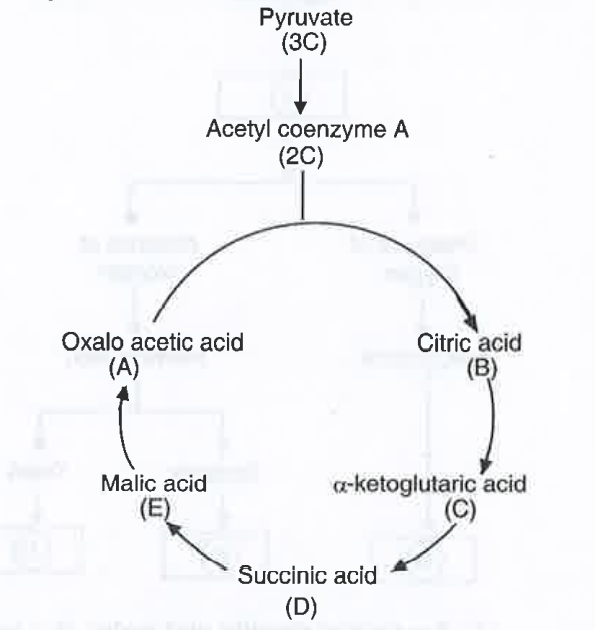The form in which carbon leaves the citric acid cycle is:
acetaldehyde
carbon dioxide
ethanol
none of these
The correct Answer is:B
To determine the form in which carbon leaves the citric acid cycle, we can follow these steps:
1. Understanding the Citric Acid Cycle: The citric acid cycle, also known as the Krebs cycle, is a series of chemical reactions used by all aerobic organisms to generate energy through the oxidation of acetate derived from carbohydrates, fats, and proteins.
2. Identifying Key Reactions: In the citric acid cycle, there are specific reactions where carbon atoms are released in the form of carbon dioxide (CO2).
3. Key Steps of Carbon Release:
- When isocitrate is converted into alpha-ketoglutarate, one molecule of carbon dioxide is released.
- When alpha-ketoglutarate is converted into succinyl-CoA, another molecule of carbon dioxide is released.
4. Evaluating the Options:
- Acetaldehyde: This compound is not produced in the citric acid cycle.
- Carbon Dioxide: As established, carbon dioxide is indeed released during specific steps of the cycle.
- Ethanol: This compound is not a product of the citric acid cycle.
- None of These: This option is incorrect since we have identified carbon dioxide as a product.
5. Conclusion: Based on the analysis of the reactions in the citric acid cycle, the correct answer is that carbon leaves the citric acid cycle in the form of carbon dioxide.
Final Answer:
The form in which carbon leaves the citric acid cycle is carbon dioxide.
---
- When isocitrate is converted into alpha-ketoglutarate, one molecule of carbon dioxide is released.
- When alpha-ketoglutarate is converted into succinyl-CoA, another molecule of carbon dioxide is released.
- Acetaldehyde: This compound is not produced in the citric acid cycle.
- Carbon Dioxide: As established, carbon dioxide is indeed released during specific steps of the cycle.
- Ethanol: This compound is not a product of the citric acid cycle.
- None of These: This option is incorrect since we have identified carbon dioxide as a product.
The form in which carbon leaves the citric acid cycle is carbon dioxide.
Topper's Solved these Questions
- RESPIRATION IN PLANTSBOOK - ICSECHAPTER - RESPIRATION IN PLANTSEXERCISE - TEST YOUR PROGRESS ( OBJECTIVE TYPE QUESTIONS ) (Fill in the blanks with appropriate words.)
8 Videos
- RESPIRATION IN PLANTSBOOK - ICSECHAPTER - RESPIRATION IN PLANTSEXERCISE - TEST YOUR PROGRESS ( OBJECTIVE TYPE QUESTIONS ) (State whether the following statements are true or false .)
22 Videos
- QUESTION PAPER -BIOLOGYBOOK - ICSECHAPTER - QUESTION PAPER -BIOLOGYEXERCISE - PART -II (Section -C)
6 Videos
- SAMPLE QUESTION PAPER 2 BOOK - ICSECHAPTER - SAMPLE QUESTION PAPER 2 EXERCISE - PART-II SECTION - C
6 Videos
Similar Questions
True about citric acid cycle
View SolutionA single turn of the citric acid cycle yields
View SolutionEnd product of citric acid/Kreb's cycle is
View Solution_____ is the 5C molecule of citric acid cycle.
View SolutionThe number of substrate level phosphoryl in one turn of citric acid cycle is:
View SolutionHow is acetyl CoA formed? What is its role in citric acid cycle?
View SolutionChoose the correct combination of labeling the number of carbon compounds in the substrate molecules, involved in the citric acid cycle

View SolutionChoose the correct combination of labelling the number of carbon compounds in the substrate molecules, involved in the citric acid cycle

View SolutionFor each acetyl Co-A oxidized by the citric acid cycle, what is the energy gain?
View SolutionIn which one of the following steps of citric acid cycle, FAD is reduced to FADH2
View Solution
